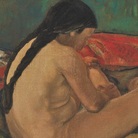La Bella di Tiziano a Palazzo Grimani

La Bella di Tiziano a Palazzo Grimani, Venezia
Dal 1 November 2013 al 26 January 2014
Venezia
Luogo: Museo di Palazzo Grimani
Indirizzo: Castello 4858
Orari: lunedì 8.15-14; da martedì a domenica 8.15-19.15
Curatori: Fausta Navarro, Giulio Manieri Elia
Enti promotori:
- Soprintendenza Speciale per il Patrimonio storico
- artistico ed etnoantropologico e per il Polo Museale della città di Venezia e dei comuni della Gronda lagunare
Costo del biglietto: intero € 4, ridotto € 3
Telefono per informazioni: +39 041 2411507
E-Mail info: sspsae-ve.grimani@beniculturali.it
Sito ufficiale: http://www.palazzogrimani.org
Dal 1 novembre al 26 gennaio, il museo di Palazzo Grimani a Campo Santa Maria Formosa ospita La Bella uno dei dipinti più celebri di Tiziano, capolavoro di assoluto rilievo della pittura rinascimentale, il ritratto di una giovane sontuosamente vestita e adorna di gioielli. Da poco restaurato dall’Opificio delle pietre dure e custodito nella Galleria palatina di Palazzo Pitti a Firenze, La Bella viene esposta a Palazzo Grimani grazie a uno scambio di opere d’arte tra istituzioni museali pubbliche. La Soprintendenza veneziana ha infatti concesso, per alcuni mesi, le Visioni dell’Aldilà di Hieronymus Bosch, conservato presso il Palazzo Grimani, all’esposizione Il Sogno nel Rinascimento che si è tenuta a Palazzo Pitti, così la Soprintendenza fiorentina ha ricambiato, offrendo La Bella.
Il progetto espositivo, a cura di Giulio Manieri Elia e Fausta Navarro, è promosso dalla Soprintendenza Speciale per il Patrimonio storico, artistico ed etnoantropologico e per il Polo Museale della città di Venezia e dei comuni della Gronda lagunare e prodotto da Venezia Accademia.
L’esposizione dell’opera è accompagnata, in mostra, dalla presentazione dei materiali illustrativi dell’intervento di restauro e dai materiali d’indagine prodotti in occasione del restauro eseguito e curato dall’Opificio delle Pietre Dure di Firenze, eseguito da Patrizia Reiitano con la direzione di Marco Ciatti dopo un’ampia campagna di indagini scientifiche.
La storia
Granduca di Urbino e Capitano Generale della Serenissima, Francesco Maria I Della Rovere acquistòLa Bella intorno al 1536-38 dopo averla vista nello studio di Tiziano durante le sedute di posa per la realizzazione del proprio ritratto e di quello della moglie Eleonora Gonzaga, nella primavera del 1536. Il 2 maggio 1536, Francesco Maria parla del dipinto in una lettera al suo ambasciatore a Venezia, il nobile pesarese Gian Giacomo Leonardi.: «Direte al Titiano …. che attenda a quel’altre cose, et che quel’ retrato di quella Donna che ha la veste azurra, desideriamo la finisca». I ritratti dei duchi giungono a Pesaro nell’aprile del 1538 ed è probabile che con essi fosse anche La Bella, tenuta già allora in enorme considerazione.
Nel 1624 La Bella risultava inventariata nel Palazzo di Casteldurante tra i dipinti ducali e, morto Francesco Maria II Della Rovere, ultimo della nobile casata, nel 1631 fu trasferita a Firenze insieme a tutta l’eredità della figlia Vittoria. La Bella passò nel 1694 in eredità al cardinale Francesco Maria e, dopo la sua morte nel 1711, al Granduca Cosimo III. Sempre registrata a Palazzo Pitti nel corso del Settecento, fu inserita nella Galleria Palatina sin dagli albori della sua formazione, alla fine del XVIII secolo.
L’identificazione della Bella
La ricerca dell’identità de La Bella di Tiziano ha costituito da sempre il tema principale degli studi storico-artistici sul dipinto. A partire dalla finire dell’Ottocento le considerazioni dei critici si dividono sull’identità da attribuire alla donna raffigurata: nobildonna (identificata in particolare con Eleonora Gonzaga, duchessa d’Urbino), o sconosciuta cortigiana?
All’apertura del Novecento, la pubblicazione ad opera di Alessandro Luzio della lettera di Francesco Maria della Rovere a Gian Giacomo Leonardi ha segnato una pietra miliare della vicenda, presupposto per nuove ricerche documentarie e precisazioni successive. Con la pubblicazione del documento, il campo delle ipotesi per i sostenitori del “partito pro-identificazione” della Bella con Eleonora Gonzaga apparve, ma solo provvisoriamente, sgomberato dalla possibilità di spendere il nome della duchessa, dato che, se il quadro avesse raffigurato la nobildonna, Francesco Maria Della Rovere lo avrebbe scritto.
Oggi si tende però a credere, sulla scia degli studi di area anglosassone, che il quadro non sia un vero ritratto, bensì un’immagine di bellezza femminile idealizzata, secondo una voga già affermata in quegli anni nella tradizione veneta della raffigurazione delle “Belle Donne”, alla quale Tiziano ha saputo conferire una forma espressiva nuova.
L’intervento di restauro
Il dipinto La Bella arrivò a Firenze nel 1631 con i beni dei Della Rovere e rimase per quattro secoli quasi ininterrottamente negli appartamenti di Palazzo Pitti ed è stata oggetto, più che di restauri complessi e invasivi, di una regolare manutenzione. L’immagine risultava nel complesso offuscata e appiattita da spesse vernici.
Dopo un’ampia campagna di indagini scientifiche e di ricerche storico artistiche, l’Opificio delle pietre dure ha eseguito un intervento di pulitura che ha alleggerito la complessa stratificazione di vernici e velature non originali ed eliminato una serie di ridipinture.
Sono state eseguite poi la revisione del telaio, la stuccatura, la reintegrazione delle piccole lacune e la verniciatura finale. Sono così riemersi particolari prima illeggibili e preziosi passaggi cromatici. Oggi, nonostante alcune deterioramenti dovuti al tempo e agli interventi di restauro del passato, sono restituiti alla visibilità il delicato velo trasparente, le ombre fredde dell’incarnato e la straordinaria resa dei tessuti.
Il progetto espositivo, a cura di Giulio Manieri Elia e Fausta Navarro, è promosso dalla Soprintendenza Speciale per il Patrimonio storico, artistico ed etnoantropologico e per il Polo Museale della città di Venezia e dei comuni della Gronda lagunare e prodotto da Venezia Accademia.
L’esposizione dell’opera è accompagnata, in mostra, dalla presentazione dei materiali illustrativi dell’intervento di restauro e dai materiali d’indagine prodotti in occasione del restauro eseguito e curato dall’Opificio delle Pietre Dure di Firenze, eseguito da Patrizia Reiitano con la direzione di Marco Ciatti dopo un’ampia campagna di indagini scientifiche.
La storia
Granduca di Urbino e Capitano Generale della Serenissima, Francesco Maria I Della Rovere acquistòLa Bella intorno al 1536-38 dopo averla vista nello studio di Tiziano durante le sedute di posa per la realizzazione del proprio ritratto e di quello della moglie Eleonora Gonzaga, nella primavera del 1536. Il 2 maggio 1536, Francesco Maria parla del dipinto in una lettera al suo ambasciatore a Venezia, il nobile pesarese Gian Giacomo Leonardi.: «Direte al Titiano …. che attenda a quel’altre cose, et che quel’ retrato di quella Donna che ha la veste azurra, desideriamo la finisca». I ritratti dei duchi giungono a Pesaro nell’aprile del 1538 ed è probabile che con essi fosse anche La Bella, tenuta già allora in enorme considerazione.
Nel 1624 La Bella risultava inventariata nel Palazzo di Casteldurante tra i dipinti ducali e, morto Francesco Maria II Della Rovere, ultimo della nobile casata, nel 1631 fu trasferita a Firenze insieme a tutta l’eredità della figlia Vittoria. La Bella passò nel 1694 in eredità al cardinale Francesco Maria e, dopo la sua morte nel 1711, al Granduca Cosimo III. Sempre registrata a Palazzo Pitti nel corso del Settecento, fu inserita nella Galleria Palatina sin dagli albori della sua formazione, alla fine del XVIII secolo.
L’identificazione della Bella
La ricerca dell’identità de La Bella di Tiziano ha costituito da sempre il tema principale degli studi storico-artistici sul dipinto. A partire dalla finire dell’Ottocento le considerazioni dei critici si dividono sull’identità da attribuire alla donna raffigurata: nobildonna (identificata in particolare con Eleonora Gonzaga, duchessa d’Urbino), o sconosciuta cortigiana?
All’apertura del Novecento, la pubblicazione ad opera di Alessandro Luzio della lettera di Francesco Maria della Rovere a Gian Giacomo Leonardi ha segnato una pietra miliare della vicenda, presupposto per nuove ricerche documentarie e precisazioni successive. Con la pubblicazione del documento, il campo delle ipotesi per i sostenitori del “partito pro-identificazione” della Bella con Eleonora Gonzaga apparve, ma solo provvisoriamente, sgomberato dalla possibilità di spendere il nome della duchessa, dato che, se il quadro avesse raffigurato la nobildonna, Francesco Maria Della Rovere lo avrebbe scritto.
Oggi si tende però a credere, sulla scia degli studi di area anglosassone, che il quadro non sia un vero ritratto, bensì un’immagine di bellezza femminile idealizzata, secondo una voga già affermata in quegli anni nella tradizione veneta della raffigurazione delle “Belle Donne”, alla quale Tiziano ha saputo conferire una forma espressiva nuova.
L’intervento di restauro
Il dipinto La Bella arrivò a Firenze nel 1631 con i beni dei Della Rovere e rimase per quattro secoli quasi ininterrottamente negli appartamenti di Palazzo Pitti ed è stata oggetto, più che di restauri complessi e invasivi, di una regolare manutenzione. L’immagine risultava nel complesso offuscata e appiattita da spesse vernici.
Dopo un’ampia campagna di indagini scientifiche e di ricerche storico artistiche, l’Opificio delle pietre dure ha eseguito un intervento di pulitura che ha alleggerito la complessa stratificazione di vernici e velature non originali ed eliminato una serie di ridipinture.
Sono state eseguite poi la revisione del telaio, la stuccatura, la reintegrazione delle piccole lacune e la verniciatura finale. Sono così riemersi particolari prima illeggibili e preziosi passaggi cromatici. Oggi, nonostante alcune deterioramenti dovuti al tempo e agli interventi di restauro del passato, sono restituiti alla visibilità il delicato velo trasparente, le ombre fredde dell’incarnato e la straordinaria resa dei tessuti.
SCARICA IL COMUNICATO IN PDF
COMMENTI

-
 Dal 12 September 2025 al 11 January 2026
Torino | Palazzo Falletti di Barolo
Dal 12 September 2025 al 11 January 2026
Torino | Palazzo Falletti di Barolo
BRUNO BARBEY. Gli Italiani
-
 Dal 10 September 2025 al 11 January 2026
Vercelli | Chiesa di S. Marco – Spazio ARCA
Dal 10 September 2025 al 11 January 2026
Vercelli | Chiesa di S. Marco – Spazio ARCA
Guttuso, De Pisis, Fontana… L’Espressionismo Italiano
-
 Dal 6 September 2025 al 25 January 2026
Roma | Museo Storico della Fanteria
Dal 6 September 2025 al 25 January 2026
Roma | Museo Storico della Fanteria
Gauguin. Il diario di Noa Noa e altre avventure
-
 Dal 6 September 2025 al 11 January 2026
Livorno | Villa Mimbelli
Dal 6 September 2025 al 11 January 2026
Livorno | Villa Mimbelli
Giovanni Fattori. Una rivoluzione in pittura
-
 Dal 21 August 2025 al 21 September 2025
Bologna | Palazzo Pallavicini
Dal 21 August 2025 al 21 September 2025
Bologna | Palazzo Pallavicini
Jack Vettriano
-
 Dal 7 August 2025 al 9 November 2025
Pesaro | Musei Civici di Palazzo Mosca
Dal 7 August 2025 al 9 November 2025
Pesaro | Musei Civici di Palazzo Mosca
Nino Caffè. Tra naturalismo e satira


